|
| Egyptian Mallow |
|

|

| File size | 51696 |
| Original date | 2/12/17 3:52 PM |
| Resolution | 700 x 525 |
| Flash | Flash fired |
| Focal length | 20.4mm |
| Exposure time | 1/4000s |
| Aperture | 11.0 |
| Focus Distance | 0.0m |
| Metering Mode | Spot |
| Camera make | FUJIFILM |
| Camera model | FinePix HS35EXR |
| Sensor type | OneChipColorArea |
|
|
|
|
Photo: |
Botanical name: Malva ludwigii Family: Malvaceae (Mallow family)
Synonyms: Althaea ludwigii, Malva malwensis, Althaea laevis
Synonyms: Althaea ludwigii, Malva malwensis, Althaea laevis
Egyptian Mallow is an annual or short-lived
perennial growing to up to 40 cm high, but often much less, with a
thick vertical root. It is named for Christian Gottlieb Ludwig, 18th
century professor of natural history and medicine. Flowers are borne
in the leaf axils, singly or in fascicles of 2 or 3, in spring.
Flower-stalks are 0.1-1 cm long, becoming longer in fruit. Flowers have
an epicalyx of 8-10 linear-lanceshaped, 4-5 mm long bracteoles. Sepals
are 5-6 mm long, elongating to 1 cm when in fruit. They are narrowly
lanceshaped, becoming triangular-ovate and tapering at the apices in
fruit. Petals are about 6 mm long, and white or pink in colour. The
staminal tube is hairy at the base. The stems are hairy. Some stems are
long, prostrate and branched, others are prostrate or rising. The leaf
stalk is slender and 1-6 cm long, decreasing in length towards the tip
of the stem. stipules are ovate-triangular, 2-6 mm long, fringed
with hairs. Leaves are 0.6-3 cm across, palmately cut, with
obovate-oblong lobes with rounded tips, and a covering of
star-shaped-hairs. The fruit is a depressed-spherical mericarp 5-6 mm
in diameter, composed of 8 to 10 mericarps. The axis of the fruit ends
in an hairy conical beak. The mericarps have sharp angles between the
lateral and dorsal faces. The lateral faces are wrinkled. The seeds are
lenticular or kidney-shaped, about 1 mm across, hairless, and brown in
color. Egyptian Mallow is found in Africa, West Asia to NW India.
| Identification credit: Surajit Koley | Photographed in Kaithal distt., Haryana. |
• Is this flower misidentified? If yes,